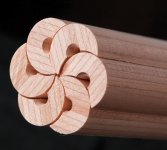That's fair .
Would it be fair to call you a knocker ?
You found out making cues takes a lot of time and sacrifices and that it wasn't that profitable for you. Now, you're knocking that industry and making fun of the people who exists in that industry ?
Again, nope. I had an epiphany that no one could really make a cue better than the production houses. I played just as well with my:
Keith Josey
Thomas Wayne
Mike Webb
Prather
Tim Prince
Paul Dayton
Ted Harris
Dan Breggin
Scott Zachow
Steve Klein
JW Petree
Dominiak
Schuler
Rick Howard
Cory Barnhart
etc
etc
As I did with a Predator, a Schon, a Joss, a Cuetec, etc.
So, I guess I'm a knocker, in the fact that the custom guy believes he can do something that the production guys can't. Dan Janes and Keith Josey are friends. They discuss cues and cuemaking all the time. And, before skins comes in and speaks for Keith, I got that information directly from both Dan AND Keith.
If you consider custom cuemaking as "art", that's fine. Like I have said earlier, the point of the thread was not to knock custom cues. It was to recognize that the quality of production cues has gone way up, not that customs have come down.
Get back to calling me an idiot, etc. What I have noticed is that there are a few of you that gravitate to arguing. And you lose sight of the original post.
I'm sorry, Joey, that you feel the need to attack me, or make comments about me - how I used to make cues, and don't anymore. Perhaps you should also knock the ton of talented cuemakers that don't make cues anymore due to them wanting more than cuemaking has to offer. Dan Breggin was extremely talented. He doesn't make cues anymore, either.
Do I have any desire to make cues again? Nope. And it has nothing to do with not being able to build a cue. It has everything to do with wanting to do other things with my time.
There's a special forest filled with special trees. These trees are reserved for the custom cuemaker. They make 30 cues a year, but you'd better believe that they make a better cue than Joss, who has made more than 100,000 cues.....because they use the word "custom". Did I get it right this time?
